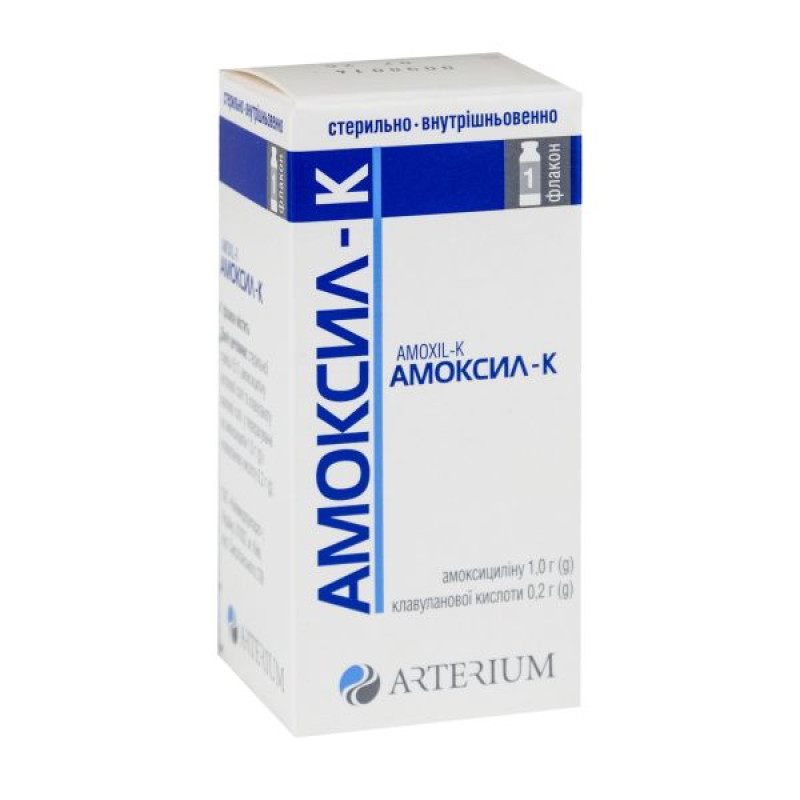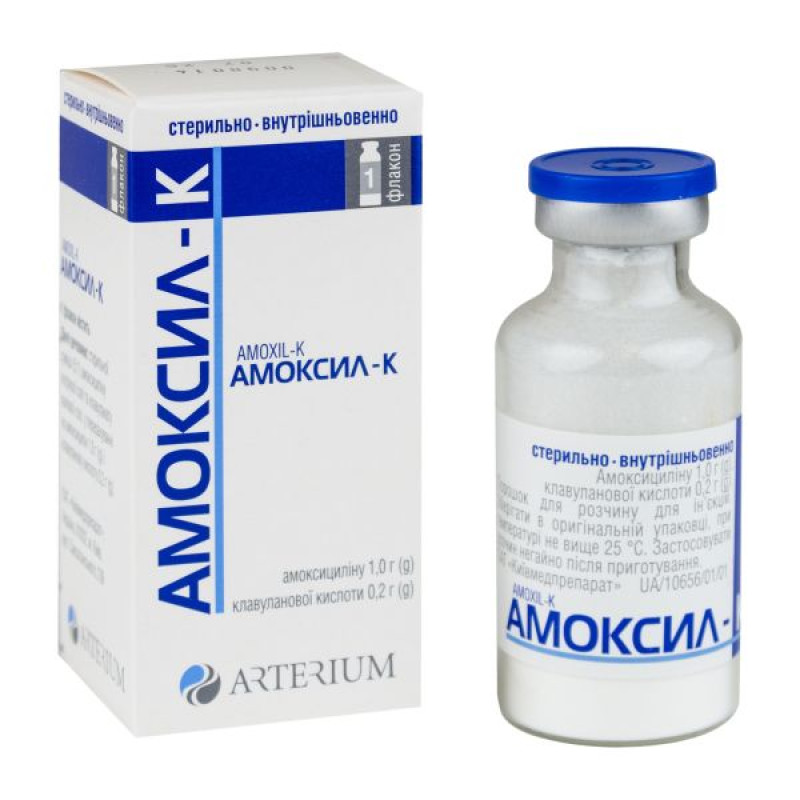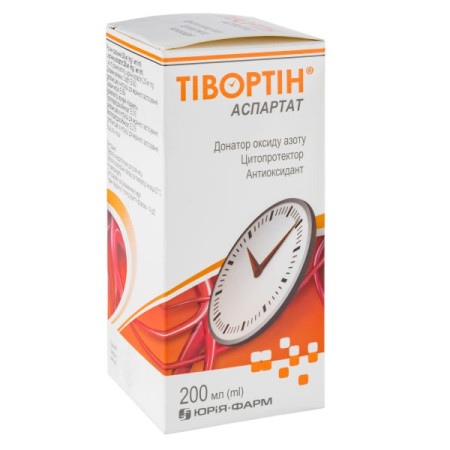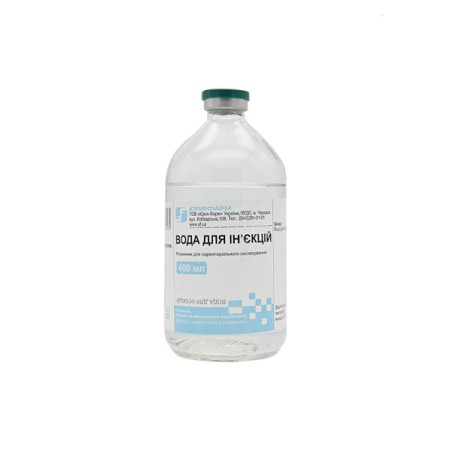Amoxil-K powder for solution for injection 1.2 g bottle No. 1

Instructions Amoxil-K powder for solution for injection 1.2 g bottle No. 1
Composition
active ingredients: amoxicillin, clavulanic acid;
1 bottle contains a sterile mixture (5:1) of amoxicillin sodium salt and clavulanate potassium salt, calculated as amoxicillin 1.0 g and clavulanic acid 0.2 g.
Dosage form
Powder for solution for injection.
Main physicochemical properties: white or almost white powder, hygroscopic.
Pharmacotherapeutic group
Antibacterial agents for systemic use. Combinations of penicillins, including those with beta-lactamase inhibitors.
ATX code J01C R02.
Pharmacological properties
Mechanism of action
Amoxicillin is a semisynthetic penicillin (beta-lactam antibiotic) that inhibits one or more enzymes (often referred to as penicillin-binding proteins, PBPs) in the biosynthetic metabolism of bacterial peptidoglycan, an integral structural component of the bacterial cell wall. Inhibition of peptidoglycan synthesis leads to weakening of the cell wall, resulting in cell lysis and death.
Amoxicillin is susceptible to cleavage by beta-lactamases produced by resistant bacteria, therefore the spectrum of activity of amoxicillin as monotherapy does not include organisms that produce these enzymes.
Clavulanic acid is a beta-lactam structurally related to the penicillins. It inactivates some beta-lactamase enzymes, thereby preventing the inactivation of amoxicillin. Clavulanic acid as monotherapy does not have a clinically useful antibacterial effect.
FC/FD ratio
exceeding the minimum inhibitory concentration (C>MIC) is considered the main factor determining the effectiveness of amoxicillin.
Resistance mechanisms
There are two mechanisms of resistance to amoxicillin/clavulanic acid:
- inactivation by bacterial beta-lactamases that are not inhibited by clavulanic acid themselves, including class B, C and D;
- conversion of PZB, which reduces the affinity of the antibacterial drug to the target.
Bacterial impermeability or efflux pump mechanism can cause or contribute to bacterial resistance, particularly in Gram-negative bacteria.
Limit values
MIC breakpoints for amoxicillin/clavulanic acid established by the European Committee on Antimicrobial Susceptibility Testing (EUCAST)
| Microorganisms | Sensitivity breakpoints (μg/mL) | ||
| Sensitive | Moderately sensitive | Resistant | |
| Haemophilus influenzae1 | ≤1 | - | > 1 |
| Moraxella catarrhalis1 | ≤1 | - | > 1 |
| Staphylococcus aureus2 | ≤2 | - | >2 |
| Coagulase-negative staphylococci2 | ≤ 0.25 | > 0.25 | |
| Enterococcus1 | ≤4 | 8 | > 8 |
| Streptococcus A, B, C, G5 | ≤ 0.25 | - | > 0.25 |
| Streptococcus pneumoniae3 | ≤ 0.5 | 1–2 | >2 |
| Enterobacteriaceae1, 4 | - | - | > 8 |
| Gram-negative anaerobic bacteria1 | ≤4 | 8 | > 8 |
| Gram-positive anaerobic bacteria1 | ≤4 | 8 | > 8 |
| Limit values not specific to specific species1 | ≤2 | 4–8 | > 8 |
1 Values reported for amoxicillin concentrations. For the purpose of susceptibility testing, the clavulanic acid concentration was set at 2 mg/L. 2 Reported values for oxacillin concentrations. 3 The breakpoints given in the table are calculated from the breakpoints for ampicillin. 4 A resistance breakpoint of R>8 mg/L means that all strains with resistance mechanisms are declared resistant. 5 The breakpoints given in the table are calculated from the breakpoints for benzylpenicillin. | |||
The prevalence of resistance of individual species may vary geographically and over time, so it is desirable to have local information on susceptibility, especially when treating severe infections. Expert opinion may be required if the local prevalence of resistance is such that the benefit of the drug, at least in some types of infections, is questionable.
| Typically sensitive species |
Gram-positive aerobes: Enterococcus faecalis, Gardnerella vaginalis, Staphylococcus aureus (methicillin-susceptible)£, Coagulase-negative staphylococci (methicillin-susceptible), Streptococcus agalactiae, Streptococcus pneumoniae1, Streptococcus pyogenes and other beta-hemolytic streptococci, Streptococcus viridans group. Gram-negative aerobes: Actinobacillus actinomycetemcomitans, Capnocytophaga spp., Eikenella corrodens, Haemophilus influenzae2, Moraxella catarrhalis, Neisseria gonorrhoeae§, Pasteurella midtocida. Anaerobes: Bacteroides fragilis, Fusobacterium nucleatum, Prevotella spp. |
| Species for which acquisition of resistance may be a problem |
Gram-positive aerobes: Enterococcus faecium$. Gram-negative aerobes: Escherichia coli, Klebsiella oxytoca, Klebsiella pneumoniae, Proteus mirabilis, Proteus vulgaris. |
| Naturally resistant microorganisms |
Gram-negative aerobes: Acinetobacter sp., Citrobacter freundii, Enterobacter sp., Legionella pneumophila, Morganella morganii, Providencia spp., Pseudomonas sp., Serratia sp., Stenotrophomonas maltophilia. Other microorganisms: Chlamydophila pneumoniae, Chlamydophila psittaci, Coxiella burnetti, Mycoplasma pneumoniae |
| £ All methicillin-resistant staphylococci are resistant to amoxicillin/clavulanic acid. § All strains resistant to amoxicillin that are not mediated by beta-lactamases are resistant to amoxicillin/clavulanic acid. 1 This formulation of amoxicillin/clavulanic acid may not be suitable for the treatment of penicillin-resistant Streptococcus pneumoniae (see sections 4.2 and 4.4). 2 Strains with reduced susceptibility have been reported in some EU countries with a frequency above 10%. |
Pharmacokinetics.
Absorption.
Pharmacokinetic data obtained in studies involving a group of healthy volunteers who were prescribed Amoxil-K at a dosage of 1000/200 mg (1.2 g) as a bolus intravenous injection are presented below.
| Average pharmacokinetic parameters | |||||
| The dose used | Amoxicillin | ||||
| Dose | Mean peak plasma concentration, μg/mL | T ½ , h (half-life) | AUC, h/mg/l (area under the concentration/time curve) | Urinary excretion 0–6 h, % | |
| Amoxil K 1000/200 mg | 1 g | 105.4 | 0.9 | 76.3 | 77.4 |
| Clavulanic acid | |||||
| Amoxil K 1000/200 mg | 200 mg | 28.5 | 0.9 | 27.9 | 63.8 |
Distribution: Approximately 25% of the total plasma volume of clavulanic acid and 18% of the total plasma volume of amoxicillin are protein bound. The apparent volume of distribution is approximately 0.3–0.4 L/kg for amoxicillin and approximately 0.2 L/kg for clavulanic acid.
After intravenous administration, amoxicillin and clavulanic acid have been found in the gallbladder, abdominal tissue, skin, adipose tissue, muscle tissue, synovial and peritoneal fluids, bile and pus. Amoxicillin does not distribute sufficiently in the cerebrospinal fluid.
Animal studies have not revealed any evidence of significant retention of substances derived from any component of the drug in body tissues. Amoxicillin, like most penicillins, can be found in breast milk. Small amounts of clavulanic acid can also be found in breast milk (see section "Use during pregnancy or lactation").
Both amoxicillin and clavulanic acid have been shown to cross the placental barrier (see section “Use during pregnancy or lactation”).
Biotransformation: Amoxicillin is partially excreted in the urine as inactive penicilloic acid in amounts equivalent to 10-25% of the initial dose. Clavulanic acid is extensively metabolized in humans and is excreted in the urine and feces and as carbon dioxide in exhaled air.
Excretion: The primary route of excretion of amoxicillin is the kidney, while clavulanic acid is excreted both renally and by extrarenal mechanisms.
In healthy volunteers, the mean elimination half-life of amoxicillin/clavulanic acid is approximately one hour and the mean total clearance is approximately 25 l/h. Various studies have shown that urinary excretion is 50-85% for amoxicillin and 27-60% for clavulanic acid over a 24-hour period. The greatest amount of clavulanic acid is excreted within the first 2 hours after administration.
Concomitant use of probenecid slows down the elimination of amoxicillin, but does not delay the renal excretion of clavulanic acid (see section "Interaction with other medicinal products and other types of interactions").
Age. The elimination half-life of amoxicillin is identical in children aged 3 months to 2 years, older children and adults. For children (including premature infants) in the first week of life, the frequency of administration should not exceed twice daily due to the immaturity of the renal excretion pathway. Since elderly patients are more prone to decreased renal function, dosage should be selected with caution, and monitoring of renal function is also recommended.
Renal impairment. The total serum clearance of amoxicillin/clavulanic acid decreases proportionally with decreasing renal function. The decrease in drug clearance is more pronounced for amoxicillin than for clavulanic acid, since a greater proportion of amoxicillin is excreted by the kidneys. In renal insufficiency, the dosage should prevent excessive accumulation of amoxicillin while maintaining adequate levels of clavulanic acid (see section 4.2).
Hepatic impairment: Caution is recommended in patients with hepatic impairment and regular monitoring of liver function is recommended.
Indication
Treatment of bacterial infections caused by microorganisms sensitive to Amoxil-K, such as:
severe infections of the throat, nose and ear (such as mastoiditis, peritonsillar infections, epiglottitis and sinusitis with associated severe systemic signs and symptoms);
exacerbation of chronic bronchitis (after confirmation of the diagnosis);
community-acquired pneumonia;
cystitis;
pyelonephritis;
skin and soft tissue infections, including bacterial cellulitis, animal bites, severe dentoalveolar abscesses with widespread cellulitis;
bone and joint infections, including osteomyelitis;
intra-abdominal infections;
Prevention of bacterial infections during major surgical interventions in the following areas:
gastrointestinal tract;
pelvic organs;
head and neck;
bile ducts.
When prescribing antibacterial drugs, one should follow the rules for their proper use.
Contraindication
Hypersensitivity to the active substances, penicillin and other components of the drug.
History of a severe immediate-type allergic reaction (e.g. anaphylaxis) to another beta-lactam antibiotic (cephalosporin, carbapenem or monobactam).
History of jaundice/liver dysfunction caused by amoxicillin/clavulanic acid.
Interaction with other medicinal products and other types of interactions
Oral anticoagulants
Oral anticoagulants and penicillin antibiotics are widely used in clinical practice without any reports of interactions. However, cases of increased international normalization ratio have been described in patients taking acenocoumarol or warfarin who were prescribed a course of amoxicillin. If concomitant use of such drugs is necessary, the prothrombin index or international normalization ratio should be carefully monitored when amoxicillin is added or discontinued. In addition, dose adjustment of oral anticoagulants may be required (see sections 4.4 and 4.8).
Methotrexate
Penicillins may reduce the excretion of methotrexate, causing a potential increase in toxicity.
Probenecid
Concomitant use of probenecid is not recommended. Probenecid reduces the renal tubular secretion of amoxicillin. Concomitant use of probenecid may result in increased and prolonged blood levels of amoxicillin (but not clavulanic acid).
Mycophenolate mofetil
In patients treated with mycophenolate mofetil, the overdosage concentration of the active metabolite mycophenolic acid may decrease by approximately 50% after initiation of oral amoxicillin/clavulanic acid. This change in overdosage level may not fully reflect the change in total mycophenolic acid exposure. Therefore, a change in mycophenolate mofetil dosage is not usually necessary unless there is clinical evidence of graft dysfunction. However, close monitoring is necessary during concomitant use and for some time after antibiotic therapy.
Application features
Before initiating therapy with Amoxiclav, careful inquiry should be made regarding history of hypersensitivity reactions to penicillins, cephalosporins, or other beta-lactam drugs (see sections "Contraindications" and "Adverse Reactions").
Serious and sometimes fatal cases of hypersensitivity (including anaphylactoid reactions and severe cutaneous adverse reactions) have been reported in patients receiving penicillin therapy. Hypersensitivity reactions may also progress to Kounis syndrome, a serious allergic reaction that may lead to myocardial infarction (see section 4.8). These reactions are most likely to occur in individuals with a history of similar reactions to penicillin. If allergic reactions occur, Amoxiclav should be discontinued and appropriate alternative therapy instituted.
If the infection is proven to be caused by microorganisms susceptible to amoxicillin, consideration should be given to switching from amoxicillin/clavulanic acid to amoxicillin in accordance with official recommendations.
Amoxicillin-C in this dosage form is not suitable for use in cases where there is a high risk that the likely causative agents of the disease have resistance to beta-lactam drugs that is not mediated by beta-lactamases susceptible to inhibition by clavulanic acid. Since there are no specific data on T > MIC and data on oral dosage forms are marginal, this dosage form (without additional amoxicillin) may not be suitable for the treatment of penicillin-resistant S. pneumoniae.
In patients with impaired renal function or when using high doses, seizures may occur.
Amoxil-K should be discontinued if infectious mononucleosis is suspected, since the occurrence of a crust-like rash in this disease may be associated with taking amoxicillin.
Concomitant use of allopurinol during treatment with amoxicillin may increase allergic skin reactions.
Long-term use of the drug may also sometimes cause overgrowth of non-susceptible microorganisms.
The development of erythema multiforme associated with pustules at the beginning of treatment may be a symptom of acute generalized exanthematous pustulosis (see section "Adverse reactions"). In such cases, treatment should be discontinued and further administration of amoxicillin is contraindicated.
Hepatitis occurs mainly in men and elderly patients and may be associated with long-term treatment with the drug. Very rarely, such adverse reactions may occur in children. Signs and symptoms of the disease occur during or immediately after treatment, but in some cases may occur several weeks after the end of treatment. These phenomena are usually reversible. Fatal cases have been observed extremely rarely, which always occur in patients with severe underlying disease or in patients who are simultaneously treated with drugs that have a negative effect on the liver (see section "Adverse reactions").
Antibiotic-associated colitis has been reported with nearly all antibacterial agents and may range in severity from mild to life-threatening (see section 4.8). Therefore, it is important to keep this in mind when patients develop diarrhoea during or after antibiotic treatment. If antibiotic-associated colitis occurs, Amoxiclav should be discontinued immediately, medical advice should be sought and appropriate treatment should be initiated.
Drug-induced enterocolitis syndrome (DIES) has been reported, mainly in children receiving amoxicillin/clavulanic acid (see section 4.8). Drug-induced enterocolitis syndrome is an allergic reaction with the main symptom being prolonged vomiting (1-4 hours after
During long-term therapy, it is recommended to monitor the functions of organs and body systems, including the kidneys, liver, and hematopoietic system.
Rarely, patients taking Amoxil-K and oral anticoagulants may experience an abnormal prolongation of prothrombin time (increased international normalized ratio (INR)). Appropriate monitoring is necessary when anticoagulants are taken concomitantly. Dose adjustment of oral anticoagulants may be necessary to maintain the required level of anticoagulation (see sections "Adverse reactions" and "Interaction with other medicinal products and other forms of interaction").
In patients with renal insufficiency, the dose should be adjusted according to the degree of renal impairment.
In patients with reduced urine output, crystalluria (including acute kidney injury) may occur very rarely, mainly with parenteral administration of the drug. Therefore, when using high doses of amoxicillin, adequate fluid intake and monitoring of urine output are recommended to reduce the possibility of amoxicillin crystalluria (see sections "Adverse reactions" and "Overdose").
During treatment with amoxicillin, enzymatic reactions with glucose oxidase should be used to determine the level of glucose in the urine, as other methods may give false-positive results.
False-positive Aspergillus test results have been reported in patients receiving amoxicillin/clavulanic acid (using the Bio-Rad Laboratories Platelis Aspergillus EIA test). Therefore, such positive results in patients receiving amoxicillin/clavulanic acid should be interpreted with caution and confirmed by other diagnostic methods.
The presence of clavulanic acid in Amoxil-K may cause nonspecific binding of IgG and albumin on erythrocyte membranes, which may, as a result, cause a false-positive Coombs reaction.
This medicinal product contains 62.95 mg (or 2.7 mmol) of sodium per vial. Caution should be exercised when administering this medicinal product to patients on a controlled sodium diet.
This medicinal product contains 39.24 mg (or 1.0 mmol) of potassium per vial. Caution should be exercised when used in patients with reduced kidney function or those on a controlled potassium diet.
Use during pregnancy or breastfeeding
Pregnancy. Animal reproduction studies with oral and parenteral formulations of amoxicillin/clavulanic acid have not revealed any teratogenic effects. In one study involving women with premature rupture of membranes, it was reported that prophylactic use of Amoxil-K may be associated with an increased risk of necrotizing enterocolitis in newborns. The drug should be avoided during pregnancy, especially in the first trimester, unless, in the opinion of the physician, such use is essential.
Breastfeeding. Both active components of the drug are excreted in breast milk (there is no information on the effect of clavulanic acid on a breastfed infant). Diarrhea and fungal infection of the mucous membranes may occur in a breastfed infant, so breastfeeding should be discontinued. The possibility of allergic reactions should be taken into account. Amoxil-K can be used during breastfeeding only if, in the opinion of the doctor, the benefit of the use outweighs the risk.
The ability to influence the reaction speed when driving or working with other mechanisms
No studies have been conducted to study the ability to influence the reaction rate when driving vehicles or operating other mechanisms. However, the occurrence of such adverse reactions as allergic reactions, dizziness, convulsions may affect the ability to drive vehicles or operate other mechanisms.
Method of administration and doses
Doses are given as amoxicillin/clavulanic acid unless the dose of the individual component is stated.
When choosing a dose of Amoxil-K to treat a particular infection, it is necessary to consider:
expected pathogens and their expected sensitivity to antibacterial substances (see section "Special instructions for use");
severity and location of infection;
the patient's age, body weight, and renal function status, as described below.
This dosage form of Amoxil-K can be used in a daily dose of up to 3000 mg of amoxicillin and 600 mg of clavulanic acid. If a higher dose of amoxicillin is required, another form of Amoxil-K should be prescribed to avoid excessively high daily doses of clavulanic acid.
The duration of treatment is determined by the doctor individually. Some infections (e.g. osteomyelitis) require longer treatment. The duration of treatment should not exceed 14 days without evaluating the results of use and the clinical picture (see section "Peculiarities of use").
Dosage for adults and children weighing ≥ 40 kg
Standard dose: 1000/200 mg every 8 hours.
Prevention of complications during surgical interventions.
For operations lasting less than 1 hour, the recommended dose is 1000/200 mg to 2000/200 mg when administered under general anesthesia (a dose of 2000/200 mg can be achieved using another intravenous formulation of amoxicillin/clavulanic acid).
For operations lasting more than 1 hour, the recommended dose is 1000/200 mg to 2000/200 mg when administered under anesthesia, a dose of 1000/200 mg can be administered 3 times within 24 hours.
If there are clinical signs of infection in the postoperative period, a course of treatment with intravenous or oral administration of the drug should be prescribed.
Dosage for children weighing < 40 kg
Children from 3 months of age: 25/5 mg/kg body weight every 8 hours.
Children under 3 months of age or weighing less than 4 kg: 25/5 mg/kg body weight every 12 hours.
Elderly patients
No dose adjustment is required.
Kidney dysfunction
Dosage adjustments are based on the maximum recommended doses of amoxicillin.
Creatinine clearance > 30 ml/min – no dose adjustment is required.
Adults and children weighing ≥ 40 kg
| Creatinine clearance 10-30 ml/min | 1000/200 mg, then 500/100 mg 2 times a day |
| Creatinine clearance < 10 mL/min | 1000/200 mg, then 500/100 mg every 24 hours |
| Hemodialysis | First dose – 1000/200 mg, then – 500/100 mg every 24 hours + 500/100 mg after dialysis |
Adults and children weighing < 40 kg
| Creatinine clearance 10-30 ml/min | 25/5 mg/kg every 12 hours |
| Creatinine clearance < 10 mL/min | 25/5 mg/kg every 24 hours |
| Hemodialysis | 25/5 mg/kg every 24 hours + 12.5/2.5 mg after dialysis |
Liver dysfunction
Caution is required in dosing, and liver function should be monitored at regular intervals.
Amoxil-K should be administered by intravenous injection (boost) or by intermittent infusion (drip). Amoxil-K should not be administered intramuscularly.
Children under 3 months of age should be given Amoxil-K only as an intravenous infusion.
Treatment with Amoxil-K can be initiated with intravenous administration and continued with oral dosage forms.
Preparation of solution for intravenous injection
1000/200 mg: dissolve the contents of the vial in 20 ml of water for injections (final volume - 20.9 ml).
A temporary pink color may appear during dissolution, which disappears. Solutions of Amoxil-K are usually colorless or have a pale straw color.
Amoxil-K should be administered within 20 minutes after dissolution.
Preparation of solution for intravenous infusion
The 1000/200 mg solution, dissolved as above, should then be added without delay to 100 ml of infusion fluid (it is better to use a mini-container or burette). The infusion should be carried out within 30-40 minutes. Amoxil-K after dissolution is chemically and physically stable for 2-3 hours at a temperature of 25 °C or 8 hours at a temperature of 5 °C. From a microbiological point of view, the prepared solution should be administered immediately.
Intravenous infusions of Amoxil-K can be carried out using various intravenous solutions. A satisfactory concentration of the antibiotic is maintained at 5 ºС and at room temperature (25 ºС) in the recommended volumes of infusion solutions indicated below. When the drug is dissolved and stored at room temperature, infusions should be carried out within the time indicated below.
| Solution for intravenous (IV) administration | Stability period at 25 °C, hours |
| Water for injections | 3 |
| 0.9% sodium chloride solution | 3 |
| Combined sodium chloride solution (Ringer's solution) | 2 |
| Combined sodium lactate solution (Hartmann's solution) | 2 |
| 0.3% potassium chloride solution and 0.9% sodium chloride solution | 2 |












